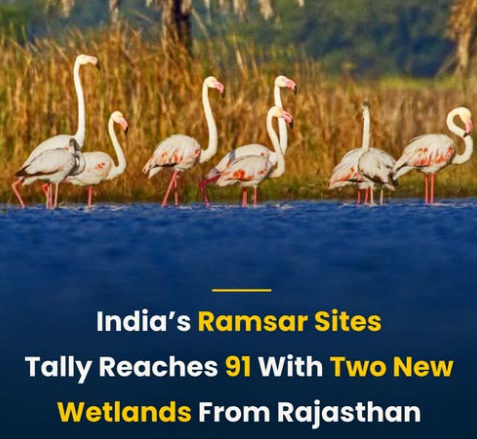
Why in News?
India has added two new Ramsar sites—Menar (Udaipur) and Khichan (Phalodi)—just before World Environment Day 2025. With these additions, India now has 91 Ramsar sites, the highest in Asia and third globally. 
About the New Ramsar Sites
Menar Wetland – Udaipur, Rajasthan
- Nickname: Bird Village
- Size: 104 hectares
- Biodiversity: Hosts over 200 bird species like Eurasian coot, herons, and spot-billed duck
- Community Conservation: Villagers prohibit hunting and fishing; declared Important Bird Area (IBA) in 2016
- Eco-Tourism Value: Located along Udaipur–Chittorgarh route, it supports bird tourism and nature walks
Khichan Wetland – Phalodi, Rajasthan
- Famous For: Large flocks of Demoiselle cranes
- Ecological Role: Acts as a critical wintering site along the Central Asian Flyway
- Community Role: Local residents maintain traditional conservation practices; birds are actively fed and protected
About Ramsar Sites
What is a Ramsar Site?
- A wetland of international importance under the Ramsar Convention, adopted in 1971 at Ramsar, Iran under UNESCO
- Aims to conserve wetlands, which support biodiversity, provide ecosystem services, and sustain local communities
India’s Status
- Signatory Since: February 1, 1982
- First Ramsar Sites (1981):
- Chilika Lake (Odisha)
- Keoladeo National Park (Rajasthan)
- Total Sites (as of June 2025): 91
- Total Area Covered: ~13.59 lakh hectares
Global Ramsar Rankings
- 1st in Asia
- 3rd globally, after:
- UK – 175 sites
- Mexico – 142 sites
Top Indian States (Ramsar Sites)
- Tamil Nadu – 20
- Uttar Pradesh – 10
- Rajasthan – 4 (after adding Menar & Khichan)
Eligibility Criteria for Ramsar Designation
A site must meet at least one of the following nine criteria, such as:
- Hosting rare/endangered species
- Supporting large bird populations
- Being a key breeding or migratory habitat
- Representing a unique or exemplary wetland ecosystem






